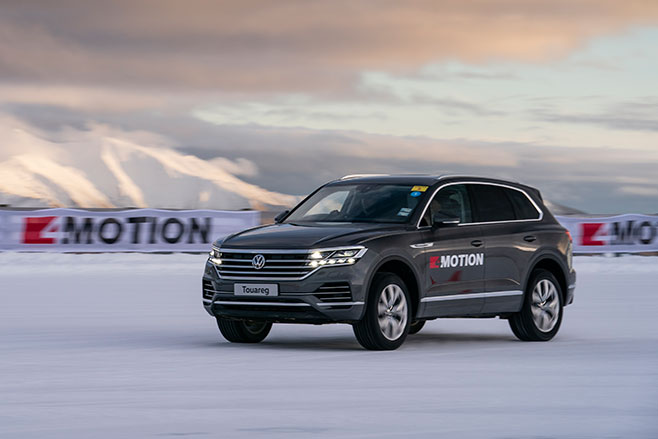
In 1980, Audi launched the iconic Quattro. At the time, the only other four-wheel drive vehicles on the road were designed with off-road intent and certainly didn’t attempt to use their all-paw traction for the enhancement of on-road performance.
Critics said the Quattro’s leftfield five-cylinder engine wouldn’t balance and its all-wheel drive system was too heavy for anything beyond ploughing fields, but two consecutive years of complete rally domination silenced the naysayers once and for all. It was the same story in 1996 when the A4 Quattro cleaned up in touring car racing.
Nearly 40 years later, there isn’t a mainstream manufacturer that doesn’t have an all-wheel drive system of some description for its passenger models, and you’ll find no better example than Volkswagen, which offers at least one variant of each model with its proprietary 4Motion system.

Officially, only the Polo compact hatchback misses out, but if you have about $330,000 to spend, Volkswagen will happily furnish you with a Polo R5 rally car. Let’s confidently say therefore, that the entire VW family is covered with at least one all-paw variant in each model line-up.
But while it’s easy to demonstrate the potential of four-wheel drive on a rally or race track, understanding day-to-day benefits of the 4Motion technology is harder. That’s why we headed to the top of a mountain in New Zealand’s Cardrona Ranges.
In Australia’s relatively warm and dry conditions, it takes a fair effort to find the limits of any all-wheel-drive system, especially on public roads.
But when you have the Southern Hemisphere Proving Ground – a 490-hectare playground of snow and ice testing facilities – at your disposal, the task of demonstrating all-wheel-drive advantages becomes a lot simpler.

It goes without saying that each of the vehicles we tested is packed with a whole host of electronic stability systems that will intervene before most drivers overstep the limits of adhesion, regardless of the surface under tyre. To reveal the raw all-paw advantage unfiltered, however, we switched the various electronic systems to their least intrusive.
First up, we unleashed the Golf R hot hatch, Tiguan mid-sized SUV, load-lugging Passat Alltrack wagon and yet-to-be released T-Roc compact SUV for an attempt at the so-called Scandinavian Flick – a maneuver that involves turning the opposite direction before entering a corner. The flick deliberately unsettles the vehicle and forces it into a slide, which can be a much more effective way of negotiating a tighter turn.

In such slippery conditions, all-wheel-drive vehicles may have a tendency to push straight ahead and slide out of the corner (understeer). Rear-wheel drives are much more likely to rotate on their central axis, especially with too much acceleration, which is known as oversteer.
But with careful application of power, counter-steering and a successful Scandinavian Flick, an all-wheel-drive can maintain a neutral slide through the corner. It takes some mastering but it’s incredibly satisfying and great to watch.
With lots of power, a short wheelbase, and a stability system that can be switched almost completely off, the Golf R was the true powerslide hero, but even the Passat, with its relatively long wheelbase, can be provoked into a slide.

Without the grip of the 4Motion system, negotiating the 180-degree turn would be a much slower process – and a lot less fun, but the clever power distributing systems direct torque to the wheels that can use it most effectively.
Next it was on to a large open expanse of beautifully groomed hard-packed snow where a slalom had been arranged. In dry conditions, a similar course would be negotiated fastest by maintaining a constant speed and narrowly passing each cone parallel to the direction of the course.

When the surface is incredibly slippery, however, the Scandinavian Flick can be used to again force the vehicle into a slide, passing behind each cone or almost 90-degrees to the direction of the course. This allows power to be applied as the cone is being passed and initiating the next slide.
Here, the Arteon, which uses the same 206kW engine as the Golf R was the star, using its slightly longer wheelbase to add stability as the speed increased. It conserved the most momentum out of the fleet and required the least amount of braking at each cone.

The faster challenge also highlights the consequences of too much speed and the importance of counter steering with the correct amount of power. Just as a satellite needs just the right velocity and angle to remain in orbit, the 4Motion system needs to send just the right amount of power to the snow, to maintain a slide. Without equilibrium, the car will either loop into a spin or push on straight ahead.
After a few laps, the course was expanded to include a few higher-speed chicanes and a wide-radius U-turn.
With their compact proportions, the Tiguan and T-Roc are an absolute delight to slide on snow, changing direction obediently and revving freely as you ask for more power. Another surprise was the pair’s Touareg larger SUV sibling, which was playful and nimble despite its size – just as it is on the road.

With a less relaxed stability control system, the Amarok struggled to let its hair down, but in a straight line, the 4Motion system found impressive amounts of grip and allowed the excellent V6 diesel engine to accelerate with an eagerness that defies the model’s size and weight.
And finally, the Crafter van might not have been the most balletic on the piste, but it too found an amazing amount of grip and refused to let its size spoil the party. Despite being a medium wheelbase variant with optional all-round glazing, the big VW threw its weight around like very few other vans could in similar conditions. If you have a package that has a destination above the snowline, there are few other commercials that can get it there as safely.

The purpose of this incredible event in the snow above Queenstown was not to critically appraise the driving dynamics or comfort features of any particular Volkswagen model – although the various character traits and how they manifest themselves in adverse conditions were fascinating.
Under the microscope was the 4Motion system and, beyond that, a broader insight into the advantages of all all-wheel drive systems.
In partnership with proper purpose-built winter tyres, the 4Motion technology really shines when you throw the very toughest environment at it, and offers a glimpse at what it is doing in slightly less extreme conditions.
In the ensuing years since the advent of road-focused adaptive all-wheel drive, the technology has evolved from an expensive luxury for diehard enthusiasts and specialist applications, to a sophisticated technology that compromises little and you’ll be glad is there, whether you know it or not.





